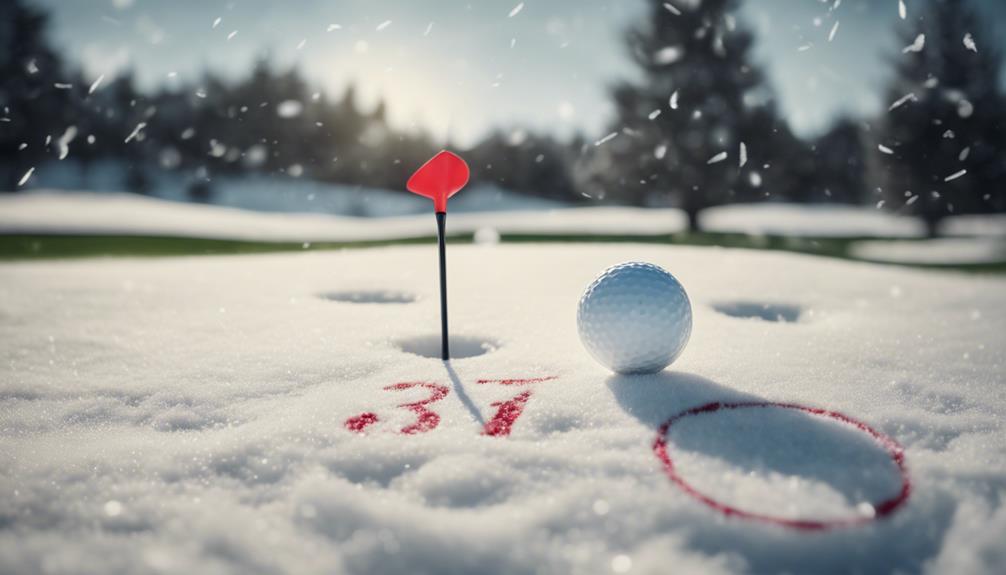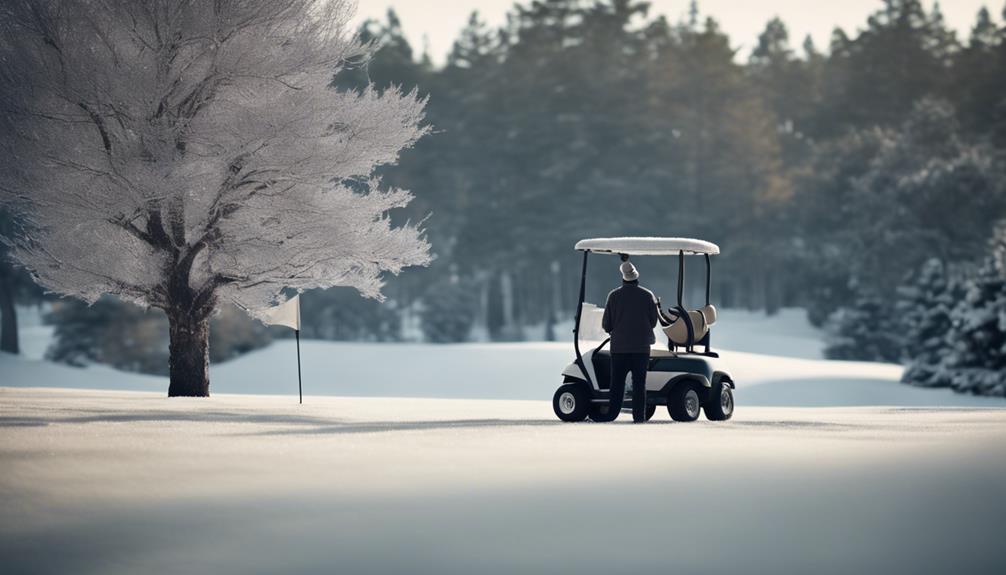- 7 Top Flite Golf Clubs XL for Improved Performance - September 28, 2024
- Top Flite Golf Clubs: Top 5 Reasons to Choose Them - September 28, 2024
- Top 3 Golf Club Fitters for a Perfect Swing - September 28, 2024
You typically enter winter golf rules on October 1, with courses adopting them to prevent damage from poor lies and excessive foot traffic during adverse weather. Generally, winter rules are in effect from October 1 to April 30, but the timing can vary based on local climate and turf conditions. Course management will announce the start of winter rules through signage or verbal communication, and it is important to understand the nuances to maximize gameplay during winter months. As you navigate the course, you'll want to familiarize yourself with the specific rules and guidelines in place to guarantee a more enjoyable round.
Key Takeaways
- Winter rules typically start on October 1 and end on April 30, but exact dates may vary depending on local climate and turf conditions.
- Course management announces the implementation of winter rules through signage or verbal communication, usually when the course is wet, muddy, or unfavorable.
- Turf assessments are conducted to determine when winter rules are necessary to protect the course from damage due to divots and foot traffic.
- Winter rules are lifted when the turf recovers, and course management informs players of the change, reverting to standard rules.
Understanding Winter Rules
What do you need to know about winter rules to guarantee a smooth and enjoyable round of golf during the colder months? As a golfer, it's crucial to understand the nuances of winter rules, also known as preferred lies, to maximize your game.
Winter rules allow you to lift, clean, and place your ball within a six-inch radius of its original position in closely mown areas like fairways. This rule is designed to prevent damage to the course from poor lies and excessive foot traffic during adverse weather.
When playing under winter rules, you'll get free relief from unfavorable lies, enabling you to place the ball in a better position to take your next shot. This adjustment is meant to enhance playability and fairness, ensuring a more enjoyable round.
When Winter Rules Apply
During periods of wet, muddy, or otherwise unfavorable course conditions, golf winter rules typically come into effect, allowing you to take advantage of preferred lies and improve your overall gameplay. As a golfer, it's important to understand when winter rules apply to guarantee you're playing by the correct rules.
You'll know winter rules are in effect when the course management announces their implementation, usually through signage or verbal communication.
In areas with closely mown grass, such as fairways and fringes, winter rules apply to mitigate the effects of poor lies. If your ball is embedded, you can take relief by lifting it, cleaning it, and placing it within a six-inch radius of its original position, or one club-length, depending on the course's policy.
When doing so, be sure to replace the ball at the nearest point where it was embedded, confirming it's not in a hazard or obstruction. By understanding when winter rules apply, you can focus on your game, knowing you're playing fairly and taking advantage of the rules to improve your score.
Implementation and End Dates

As you prepare for your next round, you'll want to know when winter rules come into play and, just as importantly, when they're lifted, as the implementation and end dates vary depending on the course and local climate.
Golf clubs typically implement winter rules from around October 1 to April 30, although this may vary based on local climate and turf conditions. The decision to apply winter rules is based on an assessment of turf conditions, aiming to protect the course from damage caused by divots and foot traffic during adverse weather.
When the turf has sufficiently recovered, management will lift winter rules, often reverting back to standard rules as weather patterns change.
Effective communication from course management is essential for players to stay informed about the status of winter rules, ensuring they understand when these rules are in effect. By doing so, golfers can adapt their gameplay to the temporary Local Rule, taking care to protect the general area and course.
Winter Golf Considerations
As you prepare to hit the course during the winter season, it's essential that you're aware of the specific considerations that come with playing in colder months.
You'll want to take note of the course's preparation tips, such as adjusted tee markers and potential restrictions on cart usage, to guarantee a smooth and enjoyable game.
Additionally, you should be prepared to take extra precautions to protect the course, like repairing ball marks and replacing divots, to maintain the quality of the turf.
Course Preparation Tips
Before teeing off, assess the course conditions and familiarize yourself with winter-specific policies to guarantee a smooth and enjoyable round.
Check the course cut, which may be higher to protect the grass, and be prepared for temporary greens, which can affect your putting strategy.
Understand the cleaning and placing rules for plugged lies, as winter conditions can make them more prevalent.
Be mindful of muddy lies, which may require adjustments to your swing and stance.
Additionally, inquire about winter policies, such as cart path only rules, to avoid any surprises during your round.
By doing so, you'll be better equipped to navigate the course and make the most of your winter golf experience.
Remember to maintain proper golf etiquette, including repairing ball marks and replacing divots, to help preserve the course during winter play.
With these tips, you'll be well-prepared to tackle the challenges of winter golf and enjoy a great game.
Winter Golf Precautions
When teeing off in winter, you should take certain precautions to assure a safe and enjoyable round, considering the unique challenges posed by winter conditions.
Before playing, always check course conditions and inquire about the specific winter policies in effect at your golf course. This will help you prepare for any adjustments to the course, such as reduced yardage due to adjusted tee markers.
Winter greens will be slower and less smooth, so adjust your putting techniques accordingly for better accuracy. Additionally, be prepared for possible walking rounds, as some courses may restrict cart usage to protect the turf.
Maintaining etiquette remains essential, including repairing ball marks and replacing divots, to help preserve course conditions during winter play.
Remember, Golf's Winter Rules are in place to assure a smooth and enjoyable game. When playing your next round, take free drops from casual water and consider taking a club length relief from plugged balls.
Familiarize yourself with the Rules of Golf to avoid any confusion or disputes. By taking these precautions, you'll be well-equipped to handle the challenges of winter golf and enjoy a great game.
Safety and Preparation Tips

As you prepare to tee off during the winter season, it's essential that you take necessary precautions to guarantee a safe and enjoyable round.
You'll want to be mindful of frosty course conditions, which can be hazardous, and prioritize your hydration and nutrition to maintain energy levels throughout the game.
Winter Golf Precautions
To guarantee a safe and enjoyable winter golfing experience, you should take necessary precautions to prepare for the unique challenges posed by cold weather conditions.
As the weather gets colder, it's important to check the course conditions before heading out to play, inquiring about specific winter policies and rule implementations at the course.
You should also be cautious of frost, ice, and slippery conditions on the course, which can increase the risk of falls and injuries. Consider wearing spiked golf shoes to enhance stability and grip on potentially slippery surfaces during winter play.
Additionally, don't forget to stay hydrated and maintain your energy levels by drinking water and packing snacks, even in colder temperatures, as exertion is still required during play.
Finally, be aware that severe weather might necessitate rescheduling your game or seeking indoor golfing alternatives, so stay informed about local weather forecasts to avoid any last-minute disruptions to your winter golf plans.
Frosty Course Conditions
Before stepping onto the frosty course, take a moment to assess the ground conditions, as icy patches and frozen grass can quickly turn a routine shot into a hazardous slip.
Frosty conditions can create slippery surfaces, so exercise caution and be mindful of your footing to avoid falls. Wear spiked golf shoes to enhance grip and stability on potentially icy or frosted areas of the course.
Before you head out, check course conditions to verify play is allowed. Frost can lead to temporary closures or restrictions, so it's crucial to apply closely to the course's guidelines.
If you decide that winter golf is for you, make sure to check with the course in advance for specific guidelines regarding frost and ice. You're entitled to free information, so don't hesitate to ask.
Hydration and Nutrition
While braving the winter elements on the golf course, you must prioritize your body's needs by fueling it with the right nutrients and staying hydrated to maintain peak performance and overall well-being.
Proper hydration and nutrition are essential to optimize your game, especially in cold weather conditions. Here are some important tips to keep in mind:
- Drink water regularly throughout your round to prevent dehydration, aiming for 16-20 ounces before heading out to the course.
- Pack nutritious snacks like nuts, energy bars, or fruit to maintain energy levels and combat fatigue.
- Bring warm drinks, such as herbal tea or hot chocolate, to stay warm and provide comfort during winter rounds.
Key Rules and Guidelines
When playing under golf winter rules, you'll need to familiarize yourself with the key rules and guidelines that govern how you can lift, clean, and place your ball to improve playability.
Winter rules allow you to lift your ball within six inches of its original position, mark the position, and drop within that radius to escape muddy or wet conditions. This courtesy is only extended to closely mown areas like fairways and fringes, so be mindful of where you're on the course.
Remember to mark the position of your ball before lifting it to guarantee a smooth and fair game. In a friendly fourball, it's crucial to communicate with your partners about the implementation of winter rules to avoid any confusion.
As you navigate the course, keep an eye out for clear signage indicating the start of winter rules, and don't hesitate to check with course management if you're unsure about the current status of the rules.
Additional Resources

Course websites, local golf associations, and clubhouse noticeboards often provide supplementary information and resources to help you better understand and navigate winter rules, so be sure to check them out before your next round. These resources can provide valuable insights and answers to questions you may have about winter rules.
You can find clear explanations of how to use winter rules, including when to place your ball and when the rules only apply.
You'll discover tips on how to adjust your game to account for wet and muddy conditions, ensuring you're prepared to tackle the course.
You may even find guidance on how to discuss winter rules with your golfing pals, ensuring you're all on the same page.
Additionally, you'll learn how to determine when a ball has come to rest in a position where you can use winter rules to your advantage.
Frequently Asked Questions
What Are Golf Winter Rules?
You need to understand that golf winter rules, allowing you to lift and place your ball, facilitate playability amidst seasonal challenges, necessitating adjustments in equipment and player etiquette, while golf course maintenance adapts to rule variations.
Can You Tee up on the Fairway Winter Rules?
Notably, you'll find that winter rules typically prohibit teeing up on the fairway, but you can take relief by lifting and placing the ball within six inches to escape poor fairway conditions, showcasing your etiquette and respect for course maintenance.
What Are Winter Greens in Golf?
You'll encounter winter greens, smaller and slower temporary putting surfaces, designed to protect turf health during harsh weather. Course maintenance practices prioritize playability, adhering to local regulations, ensuring golfers like you can play on while preserving primary greens for better conditions later.
Does WHS Have an off Season?
You might be surprised to know that over 70% of golfers play year-round, and with WHS, you can too, as it operates without an off-season, accommodating seasonal adjustments, ensuring playability despite course conditions, and considering player eligibility and weather impact.
Conclusion
As you wrap up your golf game, remember 'practice makes perfect.'
Winter rules are in place to help you navigate the challenging winter golf landscape.
By understanding when winter rules start, implementing them correctly, and considering safety and preparation tips, you'll be well on your way to improving your game.
Stay informed, stay prepared, and get ready to take on the winter golf season with confidence.




